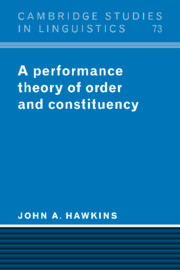Book contents
- Frontmatter
- Contents
- Preface
- Acknowledgments
- List of abbreviations
- 1 Introduction
- 2 The grammaticalization of processing principles
- 3 Early immediate constituents
- 4 Testing EIC's performance predictions
- 5 Testing EIC's grammatical predictions
- 6 Grammaticalized node construction
- 7 Conclusions
- Envoi
- Notes
- References
- Index of names
- Index of languages
- Subject index
7 - Conclusions
Published online by Cambridge University Press: 18 September 2009
- Frontmatter
- Contents
- Preface
- Acknowledgments
- List of abbreviations
- 1 Introduction
- 2 The grammaticalization of processing principles
- 3 Early immediate constituents
- 4 Testing EIC's performance predictions
- 5 Testing EIC's grammatical predictions
- 6 Grammaticalized node construction
- 7 Conclusions
- Envoi
- Notes
- References
- Index of names
- Index of languages
- Subject index
Summary
In the preceding chapters I have presented evidence and arguments in favor of the following generalization: many fundamental and abstract structural properties of grammars can be explained by simple considerations of processing ease. In other words, grammars are in large measure performance-driven, and we might use the term “Performance-Driven Grammar” to refer to this research program. This conclusion has been motivated by a close analysis of linear ordering in performance and in grammars. It is further motivated by the correspondences between on-line procedures for recognizing constituent structure and the grammatical devices that make such recognition possible. It is also supported by grammatical constraints on relativization, on movement, and on numerous other phenomena across languages.
This conclusion places performance at the core of an explanatory model of syntax, and departs from a long research tradition in which performance has been viewed as playing either no role, or only a peripheral role, in the core grammar. The role of an innate UG is correspondingly reduced, while that of (ultimately innate) processing mechanisms is increased. The processing mechanisms in question are those that make it possible for humans to recognize grammatical structure in a rapid and efficient manner. They can be seen as the syntactic counterparts of the highly efficient (and again innate) mechanisms for sound and word recognition that have been experimentally validated in numerous studies.
Information
- Type
- Chapter
- Information
- A Performance Theory of Order and Constituency , pp. 409 - 439Publisher: Cambridge University PressPrint publication year: 1995
